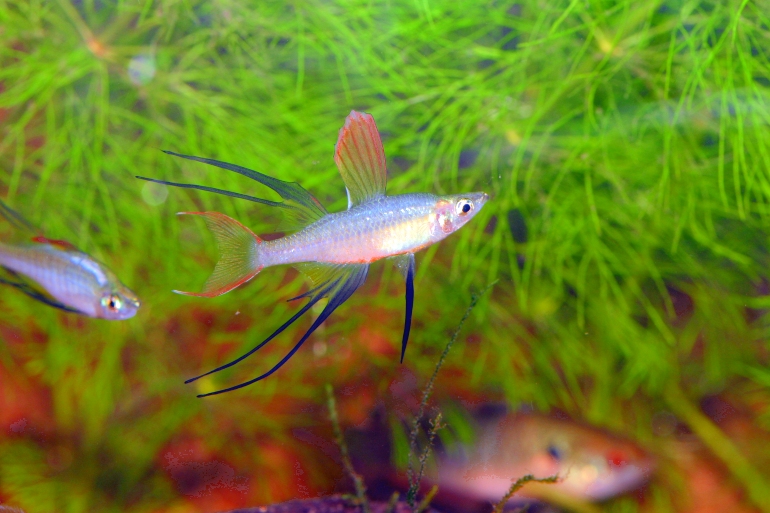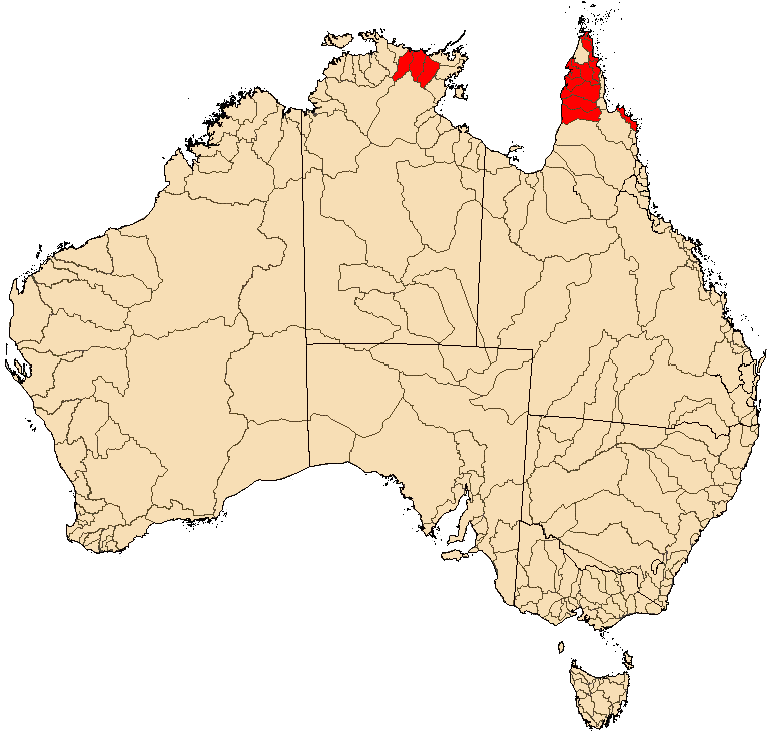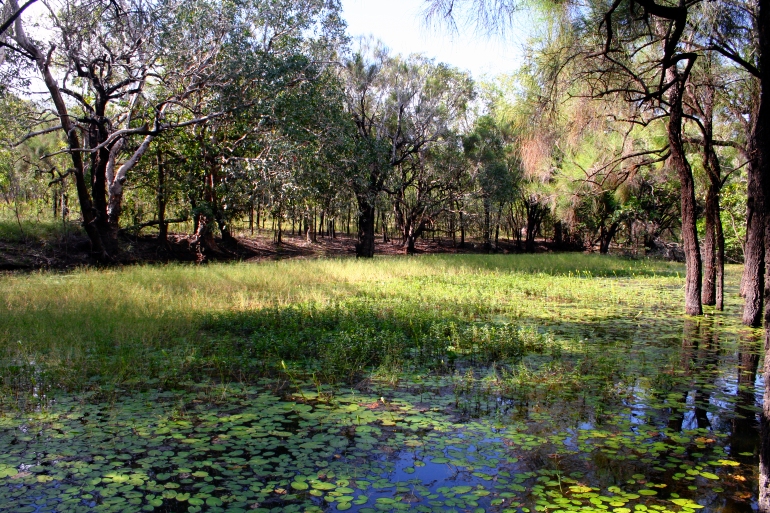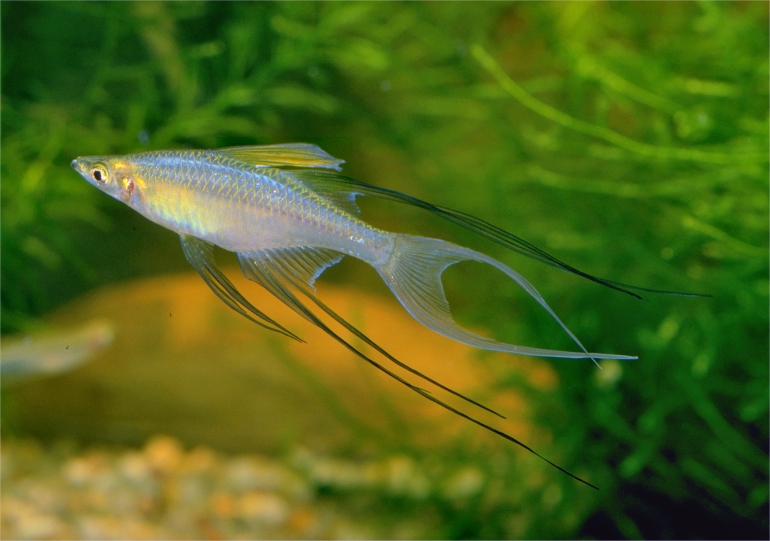 |
Iriatherina werneri (Cadell River) - photo© Dave Wilson |
Meinken, 1974
Threadfin Rainbowfish
Species Summary
In 1973, two visiting German aquarists collected some small freshwater fishes in a rice paddy field on the outskirts of the town of Merauke in New Guinea. They were transported back to Europe and a number of them were given to Herman Meinken, a well known aquarist and ichthyologist, who realised that they were an undescribed species. In 1974, Meinken published the scientific description of the fish in the German aquarium magazine Das Aquarium (Aqua Terra) and they were named Iriatherina werneri after one of the collectors, Arthur Werner. They are commonly known as the 'Threadfin' or 'Featherfin' Rainbowfish. In Australia the 'Standard Names of Australian Fishes' published by the CSIRO lists them as 'Threadfin Rainbowfish'.
Iriatherina werneri may grow to a maximum size of 5 cm, but are more commonly seen at around 3-4 cm. Mature males have a first dorsal fin that is fan shaped, while the second dorsal fin has exceptionally long filaments. The anal fin is similarly extended. This elegant finnage is used in a remarkably vivacious display for females and rival males. The body is slender, laterally compressed and general metallic silver with slightly visible dark vertical bars. The colours of the dorsal, anal and pelvic fins are black with a reddish-tan wash. The tail fin is deeply forked, transparent, and edged in a rustic red colouration. There are also small differences in fin shape and colouration of male specimens from different locations. Some males have a narrow and high sail-like first dorsal fin, while this fin is lower and broader in other males. Specimens from the Cadell River in the Northern Territory often have a more lyre-tail shaped tail fin, and the fins may be darker and longer. Females however, pale in comparison to the males, although their tail fins are adorned with a pinkish margin and the edges of the pelvic and anal fins are edged with black. The colouration of the fish in their natural habitat is usually much more intense than specimens maintained in the confines of an aquarium. Specimens found in New Guinea are usually darker than the Australian variety. A yellow finned variety has been collected from a tributary of the Embley River in northern Queensland. Although it has been reported that they lose this yellow colouration after some time being maintained in the aquarium. The colour may well have something to do with environmental conditions rather than being a distinct colour form.
 |
Distribution Map
(Absence from other catchments may reflect a lack of sampling rather than non-existence.) |
Distribution & Habitat
In New Guinea, Iriatherina werneri have been collected from several coastal rivers between the Merauke and the Fly Rivers. In the Fly River they have been collected in swampy lagoons along the mainstream of the river more than 500 km upstream from its mouth. In 1975 they were collected from Lake Bosset. Then in 2005, they were collected in 2 sites, Lake Bosset and Lake Kala.
In Australia, the Jardine River swamps were believed to be the only place where they could be found. However, in 1985 (Hansen, 1987) they were found in the Edward River catchment on the western side of Cape York Peninsula. More recent surveys have found that they have a much wider distribution in a number of river systems on both the western and eastern sides of Cape York Peninsula. They have also been collected from the Arafura Swamps and a number of streams in the Northern Territory.
Iriatherina werneri are generally found in clear, slow flowing streams, grassy wetland swamps and lagoons that have abundant vegetation. They are most commonly found along the heavily vegetated margins of lagoons and small streams at depths of 0.5 to 1.25 metres, and usually in open water not far from clumps of vegetation. Small schools of females and juveniles can be seen moving slowly through the water while the more mature males display around them. A temperature range of 22-30°C and pH values of 5.2-7.5 have been recorded in their natural habitats.
 |
Iriatherina werneri habitat, Wenlock River - photo© Gary Moores |
Keeping & Caring
Very little is known about the natural life history and ecology of the Threadfin Rainbowfish in the wild. Most information is mainly based on aquarium observations. They have been a popular aquarium fish with Australian native fish enthusiasts for many years and are easy to maintain under standard aquarium conditions. Although they are a fish that requires a little more attention than most other rainbowfishes. They are just one of the many beautiful rainbowfish species of the family Melanotaeniidae that are available to aquarium hobbyists. They should not be kept in aquaria less than 60 cm (55 litres) and are best kept in groups of 5 or more individuals. They can be maintained and bred in water conditions that are suitable for most aquarium species. However, best results will be achieved if maintained at a temperature range of 23-28°C; pH 6.0-7.0; and water hardness of 10-70 ppm (mg/L).
The Threadfin Rainbowfish is one of the most peaceful of all aquarium fishes, almost to the point of exclusion as a potential "community" tank fish. Their timidity, gentle manner, small size and dainty feeding habits put them at a disadvantage in an aquarium with most other types of tropical fishes. This is probably why they are not readily available in aquarium stores and are mostly maintained by rainbowfish enthusiasts. Nevertheless, they can be kept in a mixed community aquarium containing other small native species such as Pseudomugil gertrudae. A breeding tank can be easily set up and the fish induced to spawn throughout the year. Although some aquarists have found this species has been a difficult challenge to breed and successfully raise the newly hatched larvae.
In their natural environment they feed mainly on large quantities of unicellular, planktonic algae and diatoms. However, in captivity they seem to thrive on live brine shrimp nauplii, daphnia, copepods, mosquito larvae, and worms such as grindal and microworm. The challenge of attacking larger live foods is usually declined. Floating dry foods, such as small bite-sized pellets or flake foods are acceptable as their dorsally projected jaws are designed for surface feeding.
In their natural environment spawning usually occurs during the warmer period of the year (Spring-Summer) when water temperatures are around 24-32°C. Spawning in captivity can be attempted in a number of ways. They can be placed in a specially set up breeding aquarium with a one male; two females combination. A bunch of aquatic moss or spawning mop is placed in the tank, on which the fish will readily spawn. The spawning medium, with attached eggs, can then be removed each day, and place in a special hatching container. Alternatively, in a permanent aquarium environment purposely set up for breeding the Threadfin Rainbowfish, a self-sustaining population can be maintained. In fact, this is probably the most reliable method of breeding for the general hobbyist. Such an aquarium need not be larger than 55 litres, although a 90x45x45 cm aquarium tastefully decorated with river stones, driftwood overgrown with aquatic mosses and some floating duckweed or water sprite can be very attractive. An aquarium designed accordingly and containing a school of displaying Threadfin Rainbowfish, is a sight not easily forgotten.
 |
Iriatherina werneri [Myall Creek] - photo© Neil Armstrong |
Remarks
Preliminary genetic studies (P.J. Unmack 2009, pers. comm.) have revealed significant genetic variation between the geographically populations of Iriatherina werneri that occur in north Queensland and the Northern Territory that warrant taxonomical separation at the species level. Ongoing studies looking at the New Guinea populations may also indicate a third species.
Literature
Allen G.R. & D.F. Hoese (1980) A Collection of Fishes from the Jardine River, Cape York Peninsula, Australia. J. Roy. Soc. West. Aust. 63(2): 53 61.
Hansen B. (1987) Werneri from the wild. Fishes of Sahul 4(2): 165-168.
Meinken H. (1974) Mitteilung der Fischbestimmungsstelle des VDA, Nr. 77. Aus Neu-Guinea kommt eine neue Gattung und Art der Ährenfische (Pisces, Atherinidae). Aquarium Aqua Terra v. 8 (no. 55). 9-11.
Adrian R. Tappin
Updated September, 2015



|

